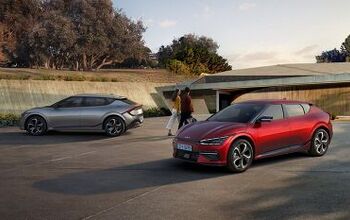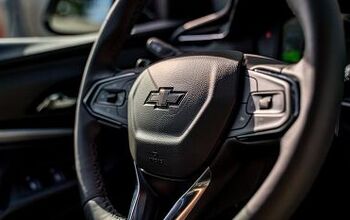The Industry Might Be Facing Disaster, But at Least Used Car Prices Are Down

The auto industry has really turned a corner over the last decade, but this year has been underlined by an unsettling lack of interest in new vehicles — potentially hinting at the return of a industry-wide crisis. The good news is that abnormally high used car prices are sinking like a stone. The flip-side of that coin, however, means that we could be approaching darker days as more consumers shy away from the new vehicle market.
Most carmakers spent last year enjoying record sales but seemed keenly aware that the market was about to plateau. However, 2017 sales have stagnated more than predicted, with rising interest rates and deflated prices seen on second-hand automobiles. It all looks very pre-recessionish and some analysts are beginning to make fearful noises.
March’s industry-wide deliveries slowed to a seasonally adjusted pace of 16.6 million annual units, far below the expectation that the market would accelerate to 17.2 million after the normal late-winter lull. At the current sales rate, deliveries are expected to fall over one-million units shy of last year’s high — but there are signs that even those numbers could be wildly ambitious, as lackluster demand isn’t the only problem.
From Bloomberg:
“Somewhat ominously, today’s market increasingly resembles one we described in ‘A Triple Threat’ (Feb. 20, 2004),” Deutsche Bank analysts Rod Lache, Mike Levine and Robert Salmon wrote in a note on Tuesday. “In that report we highlighted the risks to the industry from rising rates, rising negative equity in vehicle loans and used vehicle-price deflation. This could lead to deteriorating affordability, delayed trade-in cycles, consumer shifts from new to used, diminishing credit availability and deteriorating mix/pricing.”
We’ve written extensively on the abysmal state of the subprime loan situation, as well as the bizarre lengths companies are willing to go to reclaim the vehicles fewer and fewer lessees are able to pay for.
“Credit performance for both prime and subprime auto loan ABS is expected to continue to deteriorate, although at a moderate pace,” analysts at Bank of America Merrill Lynch said in a report from last week.
There is nothing moderate about the deterioration of used car prices, though. According Deutsche Bank, used vehicle prices declined at an accelerated rate of 7.7 percent in February after an average fall of 3.5 percent during the first nine months of 2016. Meanwhile, automakers were also offering discounts on new product. Incentive spending went up another $450 per vehicle last month as many manufacturers faced an inventory surplus.
Some of this is due to off-lease supply, though demand remains below average as people are simply less willing to let go of their current vehicle. The number of recycled cars has declined to about 11 million per year from nearly 14 million a decade ago. While there has been an influx of new drivers in recent years, it hasn’t been enough to account for the overall decline and they seem less eager to buy a replacement vehicle than anyone else.
Regardless of whether or not this spells doom for the auto industry, there are a few things that we can expect in the short term.
Swelling incentives aside, average new car transaction sums are likely to increase overall as trade-in values plummet and longer-term loans become the norm. Trade-in cycles might change too, as it would take longer for consumers to build positive equity in their current vehicles. Also, anticipate credit to get a little wonky as lenders become more cautious over collateral risk — especially for long-term leases.
While the annual forecast doesn’t look great, at least we have those temporarily low used vehicle prices as a silver lining to this dark and inauspicious cloud.

A staunch consumer advocate tracking industry trends and regulation. Before joining TTAC, Matt spent a decade working for marketing and research firms based in NYC. Clients included several of the world’s largest automakers, global tire brands, and aftermarket part suppliers. Dissatisfied with the corporate world and resentful of having to wear suits everyday, he pivoted to writing about cars. Since then, that man has become an ardent supporter of the right-to-repair movement, been interviewed on the auto industry by national radio broadcasts, driven more rental cars than anyone ever should, participated in amateur rallying events, and received the requisite minimum training as sanctioned by the SCCA. Handy with a wrench, Matt grew up surrounded by Detroit auto workers and managed to get a pizza delivery job before he was legally eligible. He later found himself driving box trucks through Manhattan, guaranteeing future sympathy for actual truckers. He continues to conduct research pertaining to the automotive sector as an independent contractor and has since moved back to his native Michigan, closer to where the cars are born. A contrarian, Matt claims to prefer understeer — stating that front and all-wheel drive vehicles cater best to his driving style.
More by Matt Posky
Latest Car Reviews
Read moreLatest Product Reviews
Read moreRecent Comments
- ABC-2000 I just got a 2024 Crosstrek, first car for me that require 6000 K or 6 month service, I have been told I better follow that schedule if i actually want to keep it.In the last consumer reports survey, it was the only car that got 99 points for reliability, let's hope they are right (:-)
- Jeff I am going to agree with Tim knobs and buttons but I realize that is low tech but much safer than scrolling thru a screen to reset your interior temperature or to turn off the radio. Also bring back the mechanical parking brake instead of the electronic one.
- Bkojote Headlight warnings need to be a thing, particularly in the era of backlit gauges and bright DRLs. Way too many people don't know how to operate a light switch on their Nissan Rogues.
- Jalop1991 going back to truth in advertising, they should just call it the Honda Recall.
- Plaincraig A way to tell drivers to move over for emergency vehicles. Extra points if it tells were it is coming from and which way you should move to get out of the way.


































Comments
Join the conversation
What I want to know is who pays for all the leased vehicle turn-ins that are worth well under the contracted residual level? If used vehicle values tank that sea of leased vehicles is going to cost some manufacturers/banks some serious money - can they afford the losses?
I like new cars. They are better than old cars. This website has a pretty good sized contingent of cheap people who place lowest possible cost as their main mission. A fair amount of Luddites too. As for me Just got a 2017 Accord Hybrid Base. List 30.5, paid 25.7. Nice ride. Quiet, smooth. I can see out out of it. 212 HP and 228 lb-ft of torque give decent throttle response. NOt too soft a ride, but plenty comfy. Averaging 46mpg so far. Pretty damn good for a car thats 73 inches wide and 194 inches long. Plenty of space for adults in front and rear seats. New tech driver assist features have mixed utility, but I am glad to have them. Might save me a lot of money and maybe my life, who knows. Lot nicer than my 2011 Accord. In fact, I realize I waited too long to get a new ride, so I leased this time.. I'll be looking to go new again in 3 years. Somebody has to do it.